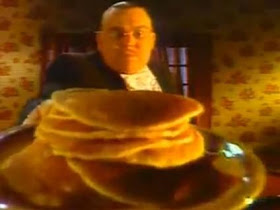
LONDON -- Today’s wedding between Britain’s Prince William and Kate Middleton will be less happy than anticipated, sources say, since the groom’s father, heir apparent Prince Charles, delivered a rambling, drunken toast over dinner last night. The most shocking revelation, according to several people who were present, was the announcement that William was adopted.
“Charles stood up — very unsteadily, I might add — and started to read a fairly conventional wedding-eve toast,” said one witness. “But then he said, ‘To hell with this,’ tore up his prepared remarks, and started to insult every member of the Royal Family, beginning with William himself.”
“Look, I know everybody says that you’re the one who looks like me, but don’t fool yourself, lad,” Charles is quoted as saying. “I mean, I don’t even see the so-called resemblance to your bleeding mother. Now Harry — there’s a real Windsor for you. Who else but my fucked-up family could produce such a git?”
Turning next to Middleton, Charles said, “Good God, woman, get out now, while you can!”
 William’s alleged birth parents are a Northumberland couple, Kwame and Eunice Nkobe, who were selected after MI5, the British secret service, conducted an exhaustive search for suitable children whom Charles and his first wife, the late Diana Spencer, might adopt.
William’s alleged birth parents are a Northumberland couple, Kwame and Eunice Nkobe, who were selected after MI5, the British secret service, conducted an exhaustive search for suitable children whom Charles and his first wife, the late Diana Spencer, might adopt.
“Oh, right, did I mention that you’re black?” Charles added, as his father, Prince Philip, went into cardiac arrest.
Eyewitnesses said that Charles might have gone on all night, had he not been wrestled to the ground by an indignant Prince Harry, and then hit over the head with a bottle of Champagne by his mother, Queen Elizabeth II. Sources close to the Royal Family say that Her Majesty’s behaviour was unrelated to the Prince’s speech; in some confusion, the Queen thought she was supposed to christen a battleship.

“Charles stood up — very unsteadily, I might add — and started to read a fairly conventional wedding-eve toast,” said one witness. “But then he said, ‘To hell with this,’ tore up his prepared remarks, and started to insult every member of the Royal Family, beginning with William himself.”
“Look, I know everybody says that you’re the one who looks like me, but don’t fool yourself, lad,” Charles is quoted as saying. “I mean, I don’t even see the so-called resemblance to your bleeding mother. Now Harry — there’s a real Windsor for you. Who else but my fucked-up family could produce such a git?”
Turning next to Middleton, Charles said, “Good God, woman, get out now, while you can!”
 William’s alleged birth parents are a Northumberland couple, Kwame and Eunice Nkobe, who were selected after MI5, the British secret service, conducted an exhaustive search for suitable children whom Charles and his first wife, the late Diana Spencer, might adopt.
William’s alleged birth parents are a Northumberland couple, Kwame and Eunice Nkobe, who were selected after MI5, the British secret service, conducted an exhaustive search for suitable children whom Charles and his first wife, the late Diana Spencer, might adopt.“Oh, right, did I mention that you’re black?” Charles added, as his father, Prince Philip, went into cardiac arrest.
Eyewitnesses said that Charles might have gone on all night, had he not been wrestled to the ground by an indignant Prince Harry, and then hit over the head with a bottle of Champagne by his mother, Queen Elizabeth II. Sources close to the Royal Family say that Her Majesty’s behaviour was unrelated to the Prince’s speech; in some confusion, the Queen thought she was supposed to christen a battleship.
































































